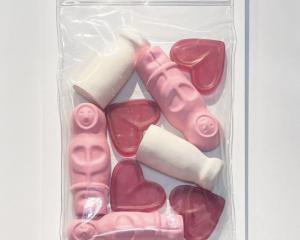Three contrasting artists present their latest work and while their paintings and prints sing very different songs, they have in common an overriding sense of the artist's person.
Catherine Garrett focuses on the landscape of her childhood. Her latest series of the West Otago region indicates her knowledge and love of this area. The bright, clear colours and bold black outlines are inspired by the work of English ceramic artist Clarice Cliff and from the effect of stained-glass windows. Much of Garrett's work focuses on the Clutha River, such as seen in Rongahere Gorge.
Manu Berry's prints are dramatic and assured. The remote back-country of the Matukituki Valley, near Lake Wanaka, is largely the inspiration behind this latest body of work with the power of the landscape being superbly captured, as in Matukituki 1. Although Berry's prints are very controlled, they are also soft and painterly with his love for the oriental subconsciously emerging to good effect.
Auckland-based artist Philippa Bentley has a fascination for butterflies and other insects. Each precise insect form is individually screen-printed on silk and hand-coloured on to old weatherboards or paper and made to replicate museum-like studies. Decorated in Kiwiana advertising, some works have handwritten notes describing personal references associated with the image.
More than 20 artists are presenting works of art for exhibition as a fundraiser for the Caselberg Trust, a trust set up to support creative endeavour in Dunedin.
The artists involved are exhibiting work based on the given theme, ''One out of the Box'', and although many of the works incorporate this theme soundly, there are some cases in which the link is tenuous. The display is, however, widely varied and contains many gems that are both innovative and imaginative.
The exhibition covers a wide range of media, from ceramics to miniature wooden boxes, jewellery, porcelain, paintings, prints and mixed media to name just a few. Work that is well situated to grab the eye is Pamela Brown's His Master's Voice. Focusing on the early UK Gramophone Company's 1899 trademark name and its famous image of a dog listening to a phonograph, Brown uses paintings, records, paper and a gramophone ''box'' to create her installation.
There are also small exquisite pieces, such as John Z. Robinson's silver brooch, Jo Regan's tiny slip-cast porcelain heads, and Claire Beynon's miniature painting and paper boat in a box. Other artwork of particular interest is Megan Campbell's Poet and Painter, a work that specifically references Anna and John Caselberg's contribution to the art and literary world of the 1960s.''
Shigeyuki Kihara is an innovative contemporary artist and curator with a career built around performance, film and photography. Much of her art is intertwined with the emotional scars left on her Pacific culture.
Kihara's exhibition of 18 large photographs takes its title from Paul Gauguin's Tahitian painting which was completed in 1897. While using Gauguin's questions to examine Samoa's culture and society, Kihara is further inspired by a 19th-century photograph, Samoan Half Caste, taken by New Zealand photographer Thomas Andrew. As the ongoing theme in each of the photographs, Kihara's lone figure wears a similar 19th-century taffeta mourning gown.
The dress' austere outline contrasts sharply with the backdrops - each highlighting pertinent issues. The figure stands as witness to scenes of political, historical, cultural and environmental importance in present-day Samoa by examining its culture and society following the 2009 tsunami, 50 years of Samoan independence and the recent destruction caused by Cyclone Evan. Kihara's work is complex, captivating and layered with meaning. Also referencing the photographic postcards of the ''South Seas'', Kihara's staged black-and-white images are the work of a skilled photographer who has the ability to recognise, organise, capture and manipulate in order to add impact and texture to her work.
- Julie Jopp.








![Untitled (c. mid 1990s, [pink 3]), by Martin Thompson, 415mm×590mm. Photo: courtesy of Brett...](https://www.odt.co.nz/sites/default/files/styles/odt_landscape_small_related_stories/public/story/2024/02/untitled_pink_3.jpg?itok=Q0aQrc9o)



